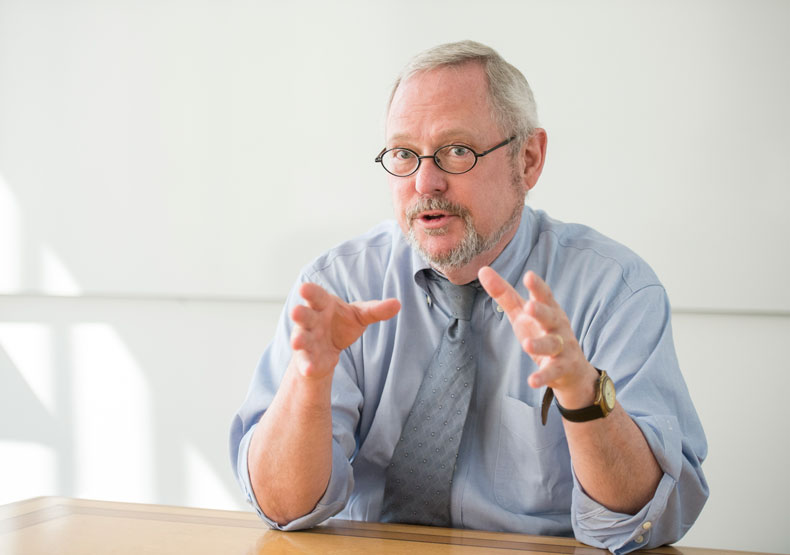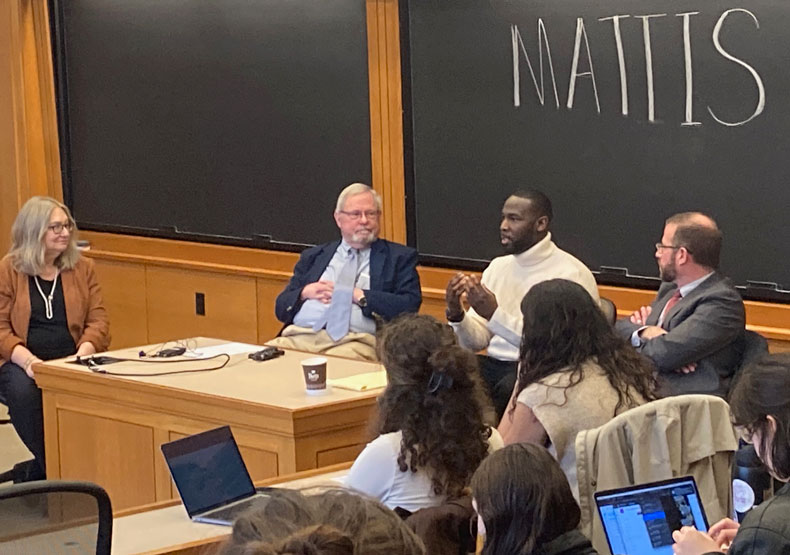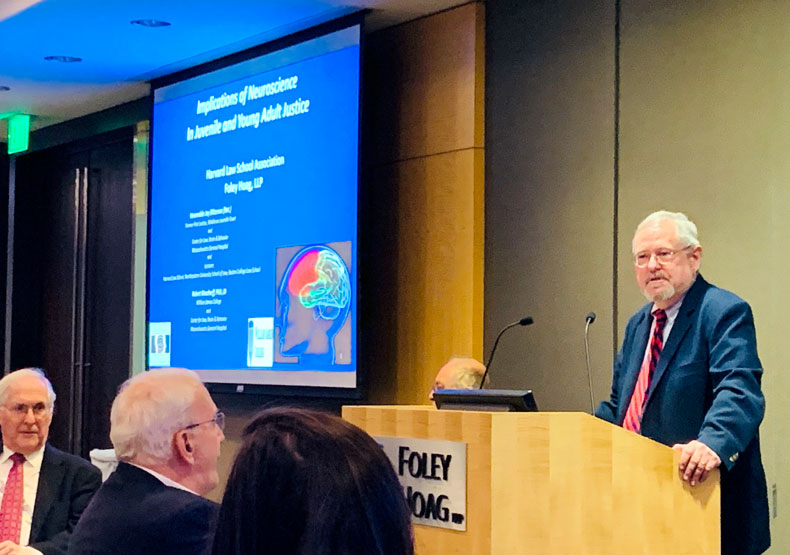Kudos to Kinscherff: Long-time Professor and Forensics Expert Contributes to Landmark Decision by State Supreme Judicial Court

Distilling the myriad career interests of Robert Kinscherff, Phd, JD, down to a single, salient takeaway begs an abundance of creativity. The self-described clinical and forensic psychologist turned attorney enjoys spending time at the intersection of neuroscience and related behavioral sciences, including psychology, with aspects of policy and law ranging from child protection and development to criminal sentencing. Kinscherff’s more than three decades of experience in this arena mean his words carry weight. In mid January, the Massachusetts Supreme Judicial Court delivered a landmark decision (Commonwealth v. Mattis) extending the state’s bar on imposing Life Without Possibility of Parole (LWOP) for any crimes committed under age 18 to include persons ages 18 through 20 at the time they committed a crime— including homicide. (In 2013, the Supreme Judicial Court relied on US Supreme Court precedent and developmental brain and behavior science in banning LWOP sentences for persons who committed murder under the age of 18.) Without Kinscherff’s live testimony, science might have missed its day in court.
“Some of the most important decisions that will impact an individual's life are made by courts and legislators,” says Kinscherff, underscoring a sobering fact: “While the notions [and beliefs] that shape [these] individuals’ decision making are often informed by science—often they are not informed by science,” says Kinscherff. For example, in working on cases of adolescents and young adults charged or convicted of very serious crimes, Kinscherff noticed an unfounded and unspoken—albeit pervasive —belief permeating sentencing practices that a young person who committed a very serious crime was likely beyond rehabilitation, particularly if the crime was an especially heinous murder. In fact, there is no science to support that assumption and most youthful offenders will desist from both minor and serious crimes as they mature, especially if provided opportunities to assume meaningful and positive adult roles. It is not even possible to reliably predict the ultimate life-course of an adolescent or emerging young adult, even those who have committed serious crimes including homicide. Indeed, recent research has established that youthful homicide offenders released from prison after their 20’s have substantially lower recidivism rates than persons imprisoned for other kinds of crime. Taken along with the evolving research on brain development among emerging adults, the presumed link between a heinous crime and limited potential for rehabilitation turns out simply to be wrong.
“Young people are capable of remarkable change and growth over the course of their lives,” says Kinscherff, a “translational” scientist keen on taking scientific research and applying it to real-world situations where understanding that brain development continues well into an individual’s twenties needs to be common knowledge. For example, a White Paper on the Science of Late Adolescence, developed by Kinscherff and his colleagues at the Center for Law, Brain & Behavior at Massachusetts General Hospital was provided as evidence in the Mattis case along with testimony from two other national experts. The same science is taught in the forensic psychology courses that Kinscherff teaches as a Professor at William James College.

“The scientific record strongly supports the contention that emerging adults have the same core neurological characteristics as juveniles have,” wrote Chief Justice Kimberly S. Budd in the majority opinion. Specifically, an enormous body of evidence about neurodevelopment demonstrates that the brains of the 20-year-old and the 13-year-old are similar when it comes to acting on impulse, taking risks, seeking immediate reward and yielding to peer influence. “As such, they must be granted a meaningful opportunity to obtain release based on demonstrated maturity and rehabilitation,” she added in the long-awaited ruling in the case of Mattis vs. Massachusetts. In 2011, 18-year-old Sheldon Mattis was sentenced to LWOP for his involvement in a homicide; the individual who fired the gun, 17-year-old Nyasani Watt, was tried and sentenced as a juvenile and deemed eligible for a parole hearing after serving 15 years. As a result of this ruling Mattis, who was sentenced as an adult, will now have the same opportunity to demonstrate his growth and rehabilitation after serving at least 20 years.
In his current role, as executive director of the Center for Law, Brain & Behavior at Mass General Hospital (CLBB), Kinscherff remains committed to making the legal system more effective and fair for those affected by the law—seeds sown in 1983 when he came to Boston for what was to be a one-year internship at Boston Children’s Hospital and The Baker Center for Children and Families. Kinscherff credits Dr. Kenneth Herman, founder of the Children and Law Program at Massachusetts General Hospital (a “rare bird” and “splendid mentor” at the time, given his dual expertise in law and psychology) as whetting the young scholar’s appetite for applying scientific knowledge to legal decisions.
“I got a taste of [what I found to be] really interesting work with the potential for significant impact,” says Kinscherff of providing reliable, science-based information capable of shaping court decisions. At the close of his internship year, he took a job at the Boston Juvenile Court clinic and the rest—as Kinscherff says—is history.
Kinscherff’s affiliation with William James College dates back to the late 1990s when he arrived on campus to co-teach the sole course in forensic psychology at the time. His early enthusiasm for developing the College’s forensic holdings and related faculty expertise led to the concentration in Forensic Psychology which Kinscherff defines as, “the use of the behavioral science of psychology in order to develop forensically defensible—meaning defensible on the method of the science—evidence to assist legislators, judges, attorneys, [and other] individuals before the court in making decisions.” Following a stint as Director of Forensic Studies, Kinscherff assumed the position of Associate Vice President for Community Engagement where he was instrumental in establishing Juvenile Court Clinics (JCC) in Suffolk and Norfolk counties operated by William James College under an agreement with the Massachusetts Department of Mental Health and the Trial Court of Massachusetts. Since joining the CLBB as Executive Director three years ago, Kinscherff retains an active teaching role on campus. He never tires of gleaning information from journals geared toward behavioral scientists and lawyers and applying it to real activities touching the lives of real people.
“That’s the part of the work I love the most,” says Kinscherff who, most days, can be found in and around the court systems, and increasingly now state legislatures across the country, delivering science-based testimony on legislation, criminal justice, and juvenile justice. For students keen on integrating psychology and the law, William James College has paved a pair of pathways—one each in the Clinical Psychology PsyD and Clinical Mental Health Counseling MA programs.
“I would encourage any person with a solid grounding in clinical psychology, looking to develop expertise in one of the areas of forensic psychology, to seriously consider William James College as a place not only to be trained but also to position themselves for an impactful career,” says Kinscherff, more confident than ever that neuroscience is poised to become inextricable from popular culture.
“What used to be an arcane enterprise is now an area of focus in increasing demand,” he says of forensic psychology courses spanning the gamut from high school to graduate level—a trend on track to become even more common in the very near future.
“[While] the people who populate the legislatures and the courts are for the most part intelligent, earnest and honorable human beings, the system itself has well-documented flaws, some of which could be remedied if we simply followed the science,” says Kinscherff, pointing to the Mattis court ruling. Upon delivery of the long-awaited decision, 203 individuals in Massachusetts sentenced to LWOP as young adults will be eligible for parole or a resentencing hearing after serving 15 years, a factor that comes with far-reaching consequences—especially among the disproportionate number of people of color entangled in the criminal justice system as well as those facing addiction and other chronic adversity.
While the tide has turned, the work is far from finished. Last fall, Kinscherff and a colleague were invited to address over 150 judges who sit on cases in immigration and asylum hearings involving minors; the topic of their talk, rooted in child development and child trauma, touched on big-picture questions including, What does a traumatized child look like? and What is the best way to engage with a child to get reliable information about their experiences and perceptions?
As to Kinscherff’s perspective of these professionals, tasked with making life-altering decisions for others on a daily basis? “They were extremely interested to know what the science had to say.”

- Tags:
- Research & Advocacy
Topics/Tags
Follow William James College
Media Contact
- Katie O'Hare
- Senior Director of Marketing
- katie_ohare@williamjames.edu
- 617-564-9389
